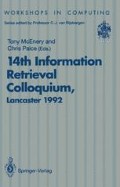Abstract
This paper describes on-going work on a new method of automatic abstracting which uses general domain knowledge in association with extracting techniques. A representation of the main concepts of a paper are stored in an abstract-frame. Each section of the abstract-frame has a group of phrases associated with it, and the occurrence of these phrases are used to extract relevant portions of text from source documents. The completed abstract-frame is then run through a program which uses an abstract template to produce a coherent, cohesive abstract.
The system is being developed with papers in the area of agriculture, specifically papers dealing with experiments, trials or observations on crops. One aim of the project however is to produce a system which may be easily transferred to other domain areas.
Access this chapter
Tax calculation will be finalised at checkout
Purchases are for personal use only
Preview
Unable to display preview. Download preview PDF.
References
Baxendale, P. B. Man-made Index for Technical Literature - An Experimentl.B.M. Journal of Research and Development. 2(4): 354–361, 1958.
Dejong, G. “An Overview of the FRUMP System.In Strategies for Natural Language Processing,”Lehnert and Ringle (eds.) 1982. Hillsdale, NJ: Lawrence Earlbaum Associates.
Edmundson, H. P. New Methods in Automatic Extracting. Journal of the Association for Computing Machinery.16(2): 264–285, 1969.
Evans, M. and A. V. Pollock. Trials on trial: a review of trials of antibiotic prophylaxis.Archives of Surgery.119: 109–113, 1984.
Kent, A.Textbook on Mechanized Information Retrieval. second edition, New York: 1966. Wiley Interscience
Kircz, J. G. Rhetorical Structure of Scientific Articles: The Case for Argumentational Analysis in Information Retrieval.Journal of Documentation.47(4): 354–372, 1991.
Liddy, E. D. The Discourse Level Structure of Empirical Abstracts: An Exploratory Study.Information Processing and Management.27(1): 55–81, 1991.
Luhn, H. P. The automatic creation of literature abstracts.I.B.M. Journal of Research and Development.2(2): 159–165, 1958.
Mathis, B. A., I. E. Rush and C. E. Young. Improvement of automatic abstracts by the use of structural analysis.Journal of the American Society for Information Science.24(2): 101–109, 1973.
Narine, L., S. Y. Deanna. T. R. Einarson and A. L. Ilersich. Quality of abstracts of original research articles in CMAJ in 1989.Canadian Medical Association Journal.=.144(4): 449–453, 1991.
Paice, C. D. “The Automatic Generation of Literature Abstracts: an approach based onself indicating phrases.”In Information Retrieval Research.Oddy, Robertson,Rijsbergen and Williams (eds.) 1981. London: Butterworths. 172–191.
Paice, C. D. Constructing Literature Abstracts by Computer: Techniques and Prospects.Information Processing and Management.26(1): 171–186,1990.
Paice, C. D. The Rhetorical Structure of Expository Texts.In The Structuring of Information.K. Jones (ed.), Proceedings of Informatics 11. London: ASLIB 1991. 1–25.
Paice, C. D. and O. D. Husk. Towards the automatic recognition of anaphoric features in English text: the impersonal pronoun it.Computer Speech and Language.2: 109–132. 1987.
Propp. V.Morphology of the folk-tale., 1958. Bloomington: Indiana University Press.
Rama, D. V. and P. Srinivasan. An investigation of content representation using text grammars.ACM Transactions on Informotion Systems. in press: 1992.
Rush, I. E . R. Salvador and A. Zamora. Automatic Abstracting and Indexing. II. Production of indicative abstracts by application of contextual inference and syntactic coherence criteria.Journal of the American Society for Information Science.22(3): 260–274, 1971.
van Dijk. T. A.Macrostructures: An interdisciplinary study of global structures in discourse. interaction. and cognition.1980. Hillsdale. NJ: Lawrence Earlbaum Associates.
Author information
Authors and Affiliations
Editor information
Editors and Affiliations
Rights and permissions
Copyright information
© 1993 British Computer Society
About this paper
Cite this paper
Jones, P.A., Paice, C.D. (1993). A ‘Select and Generate’ Approach to Automatic Abstracting. In: McEnery, T., Paice, C. (eds) 14th Information Retrieval Colloquium. Workshops in Computing. Springer, London. https://doi.org/10.1007/978-1-4471-3211-0_10
Download citation
DOI: https://doi.org/10.1007/978-1-4471-3211-0_10
Publisher Name: Springer, London
Print ISBN: 978-3-540-19808-6
Online ISBN: 978-1-4471-3211-0
eBook Packages: Springer Book Archive

